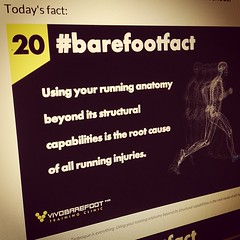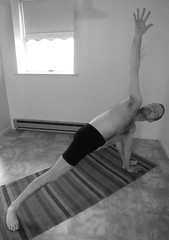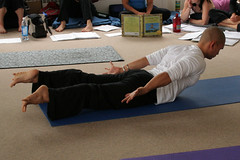Many computer users around the world face the problem of back pain. Sitting down for all or most of the day can really wreak havoc on your back. Having your back against the wall usually means you're in trouble. But for certain yoga positions, having your back firmly against a wall will aid health.
|
|
| Yoga Pose at Work - Side Stretch (Photo credit: myyogaonline) |
In Hatha Yoga, the practitioner forms what Swami Gitananda calls body geometry--triangles, straight lines, circles and parallel lines. When you do a posture, always stretch your body to its utmost limit and then hold it there for a slow count of 10, gradually building up the time, until each posture can be maintained for 30 seconds. Holding a posture is essential to yoga because it gives the body a chance to settle into the stretch and loosen up. Then each time you stretch it will be just that little bit farther.
Many of the sideways, or lateral, stretches in Hatha Yoga require that the body face forward, with hips level and back and spine tilting neither forward nor back. Beginners tend to lean forward to increase the stretch. But leaning forward is wrong and will actually detract from benefits and possibly cause harm. To perform these stretches properly, make sure to keep your spine firmly against a wall. The wall acts as a prop. Even those who have practiced yoga may find that they cannot bend as far as they thought they could when they do the postures properly. The extra time spent in forming careful postures will pay off: Your body will gain excellent flexibility and strength.
Below are a couple of yoga stretches that are excellent for computer users or other sedentary people (the Triangle pose is very similar to the Side Angle Stretch, but both legs stay straight, so it's somewhat more advanced; learn the Side Angled Stretch first):
The Side-Angled Stretch (Parshvakonasana)
Stand straight against the wall and stretch the feet about three to four feet apart. Inhale and raise arms up to shoulder level, palms down. Point right foot to the right and slightly turn in left foot. Bend right knee to form a right angle, with thigh parallel to the floor and the shin vertical. The knee should be directly above the ankle. Stretch the back leg and tighten the knee.
Exhale and stretch right hand down to rest on floor behind right foot (for a beginner version, rest elbow on bent knee). Turn head to look up and press left hip flat against wall with left hand. A strong pull should be felt all along the left side. When you feel comfortable, stretch the left arm up and press it against your ear so that from left heel to left hand the body is stretched and extended. Hold this position for a slow count of 10, making sure that upper shoulder, hip and bent knee are pressed against the wall. Inhale and return to starting position. Exhale and repeat on left.
Benefits: This posture produces overall health. It tones every muscle, tendon and joint in the body. The heart is revitalized and strengthened, and, if crooked, the spine is stretched and realigned. The hip joints, which can weaken with age, become stronger and more flexible. The neck is stretched and made more flexible, easing the pain of stiff, tense muscles and spondylosis. Thighs, hips and waist are firmed. Even digestion is improved.
Remember to lie down and relax after your yoga practice. Relaxation after exercising helps the body to recover, regulates the flow of blood, and calms and soothes the mind. That way you don't feel tired but refreshed and invigorated.
The Triangle (Trikonasana)
Stand with your back against the wall. Place your feet two or three feet apart. Keeping feet firmly on the floor, and weight balanced on heels and toes, stretch your body up, pressing shoulders back and allowing arms to hang at your sides. Inhale.
Exhale and slowly bend from waist, sliding your right hand down the right side as far as it will go. Shoulders should press back and hips should remain level, pointing forward. Head should be turned to the side, so that it's at a right angle to the body. Hold posture for 10 slow counts, inhale and come up to starting position. Exhale and repeat on left. Inhale and come up to starting position.
Exhale and rest a moment. Inhale and slowly raise arms to shoulder level, palms down. At the same time, point the right foot to the right at a 90-degree angle while keeping the left foot turned in slightly. Exhale and bend to the right, sliding hand down to ankle or foot. If possible, touch the ground behind foot. Pull hip square against wall with left hand and turn head to look up.
Inhale and raise left arm straight up over head so that arms are in a straight line. Keep hips and torso against the wall as both arms stretch, one down and one up, touching the wall. Hold posture with smooth, even breathing for a slow count of 10. Inhale, come up and repeat on left.
Benefits: Trikonasana helps produce excellent spinal flexibility. It stretches the legs, back and neck and helps to loosen up the hips and make them strong and flexible. It is also, to some extent, a balance posture; in yoga, it is believed that the skill developed in physical balance has a profound effect on the mind, quieting unruly emotions and creating calm. It is one of the best postures for slimming the waist, hips, arms and legs. Remember to breathe deeply in when stretching up and breathe deeply out when bending the body downward.


















